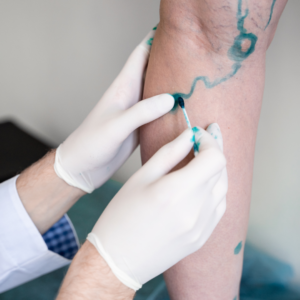



Have you ever noticed bulging, twisted veins on your legs? These are varicose veins, a common condition affecting almost 30% of the Indian population. Women are 2 to 3 times more likely to develop them than men. This blog aims to provide comprehensive information about varicose veins, their causes, symptoms, and various treatment options, helping readers make informed decisions about their health.
Varicose veins are swollen, twisted veins visible just under the skin's surface, commonly found in the legs. This is when the valves in the veins that help blood flow towards the heart stop functioning appropriately, causing blood to pool in the veins, making them enlarged and twisted.
Several factors can contribute to the development of varicose veins:

Varicose veins can be easily recognised by their appearance:
Traditional methods included vein stripping and ligation, which involved removing or tying off affected veins. These procedures often required hospital stays and longer recovery periods. Modern treatments offer advanced and less invasive approaches, typically involving minimal downtime and performed on an outpatient basis.
Gone are the days of invasive surgeries for varicose veins. Today, minimally invasive procedures offer safe and effective solutions. Here are two leading procedures:
Ablation therapy is a minimally invasive technique that uses heat to close off varicose veins, leading to their collapse and eventual absorption by the body.
Types of Ablation:
Procedure: A narrow catheter is inserted into the vein during the procedure. The catheter then delivers heat through radiofrequency or laser energy, causing the vein walls to collapse and seal shut. The procedure is usually performed under local anaesthesia.
The Venaseal procedure involves using a medical glue to close off varicose veins. This glue seals the vein, and blood is rerouted through healthier veins.
Procedure: A catheter is inserted into the affected vein, delivering a small amount of adhesive to seal the vein. Venaseal does not require heat, unlike ablation therapy, making it a unique option.
Effectiveness: Venaseal has shown high success rates and positive outcomes. Patients report a major improvement in symptoms and the appearance of their legs.
Both ablation therapy and the Venaseal procedure offer significant advantages over traditional methods for treating varicose veins:

When considering the specific advantages of each approach, ablation therapy is often preferred for treating larger varicose veins. The Venaseal procedure offers a unique benefit as it is the least time-consuming and painful of all the procedures.
Adhering to your doctor's post-treatment recommendations will help in a smooth recovery and maximize the long-term success of the treatment.
If you doubt you have varicose veins, it is essential to seek professional advice. Schedule a consultation with Dr Akhil Monga, who specializes in diagnosing and treating varicose veins with the latest techniques, including ablation therapy and Venaseal. Contact him today to discuss the most suitable treatment option for you. Don't let varicose veins affect your life any longer€”take the first step towards healthier veins today.